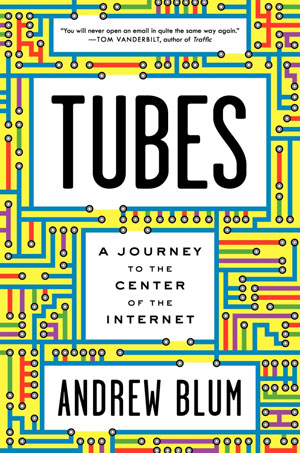There's a revelatory scene in Terry Zwigoff's film, Crumb, in which the titular artist demonstrates his signature technique for revealing the grittiness of the real— telephone poles, cables, all of the varied rooftop flora of our urban infrastructure—in his cityscapes.

When we think of the Internet (and often when we write about it) we generally see it as an ethereal realm of boundary-erasing placelessness. But our data actually makes its way through tangled knots of wire and fiber-optic cable, pulled through subterranean (and suboceanic) depths by workers whose names never make it into the Wall Street Journal or Fast Company, connecting network gear in rooms full of server hardware, generally in exotic locales like Ashburn, Virgina; and The Dalles, Oregon.
Andrew Blum presents us with this latter Internet in Tubes: A Journey to the Center of the Internet. Blum (who's written about the intersection of architecture and technology for outlets ranging from Gizmodo to Wired to Metropolis) sets out to make us aware of the physical details that give shape to the cloudy ambiguities of online life, grounding our increasingly virtual interactions in lived experience, built environment, and labor.
If you've read any of the popular literature on the history of the Internet or computing, some of this will seem familiar—the short account of the ARPANET's evolution and a visit to the nondescript room at UCLA where the Internet as we know it had its birth recalls Katie Hafner and Matthew Lyon's Where Wizards Stay Up Late (that title taken from a poem of James Merrill). Likewise, Blum’s accounts of the social world of network engineers and the managers who connect networks, run data centers, and plan cable operations brings to mind Tracy Kidder's classic Soul of a New Machine.
Blum's topical focus, however (and this is what differentiates Tubes from the majority of popular tomes on similar topics), is always on physical infrastructure, and, more often than not, on the everyday folks who build and maintain it . ("These guys," Blum writes of his subjects, "aren't Steve Jobs or Mark Zuckerberg"). But the journey he sets out on is, as he often reminds the reader, a quest...a romantic adventure, a pilgrimage to visit the Internet, in person, building, in the process, a catalog of the Ballardian monuments of our age, with a Studs Terkel twist. It is especially poignant during his visits with front-line network tech personnel like Facebook data center manager Ken Patchett in Prineville Oregon, and cable techs Brian Seales and Eddie Diaz of New York City's Hugh O'Kane Electric Company.
But as you might gather from the book's title (taken from the late Alaska senator Ted Stevens' famous description of the Web as a "series of tubes," a metaphoric gaffe for which he's since been vindicated), Tubes is first and foremost a journey into metaphor. Blum is trying, more or less, to situate utopia, a project that's always bound to be fraught with problems. As Thomas More noted long ago, the perfect state is, ultimately, no place at all. So we get something with a touch of Pynchon— there's even a meditation on power inspired by the generator scene in The Education of Henry Adams—in our wandering na'f as he makes his way to an audience with the central Mystery of technology, albeit in a centerless world (and that's really the best explanation for the subtitle, since Blum knows full well—and tells us from the start—that the “Net is centerless”).
Blum did extensive fieldwork and conducted countless interviews in the two years he was at work on the book, but for all the detail, his ultimate insight is the realization that the Internet is neither a physical nor a virtual world, but a human one. That is clearly true, but it raises more questions than the book can answer. Blum seems somewhat awed by the realization that social relationships were driving forces in the Internet's evolution (and we get a fair amount of fly-on-the-wall gossip about network engineer dealmaking sessions), but it all just seems like business is going on.
The thing is, though it may not be geographic, there is a clear center to the Internet these days. And that's bound up in a particular sort of human relationship—a monetary one. Its presence here is obscured by the author's obvious (and understandable) nostalgia for the old, pre-commercial Internet with its collegial relationships.
There is a particularly affecting chapter that highlights this and points to the book's primary lacuna. Denied access to anything interesting at Google's flagship data center in central Oregon, Blum takes the affront personally. His frustration with Google's corporate secrecy is one of the book's most interesting moments. Having been met with warm welcomes, open access, and easy conversation at most of the Internet's most significant exchanges, Google's closed-door policy and studied PR-speak (he calls the reps “Google-bots”) marks the presence of a force as “real” as cables and server rooms. That’s the harsh reality of dollars, the commercial entities carving off their leases and circling their wagons against the gentlemen’s agreements that maintained the old—and far more collegial—networks.
The mysterious force that shapes today's network is, ultimately, economic, but in Tubes, money—the dark matter that shapes the Internet—remains hidden in the background. The physical spaces Blum visits make “legible” for him, a basic idea of network relationships being equivalent to human relationships. “There are different kinds of connection. There are the connections between people, the million kinds of love,” he writes. But I'm not sure such metaphors have explanatory power. Those connections might have been better clarified by a more extended discussion of the market and policy forces at work.
Maybe that's another book altogether (a definitive economic history of the Internet has yet to be written). In Tubes Blum has given us what he set out to produce...an intriguing travel guide to the little-visited places and spaces of the Internet. This volume certainly has real value for those who have been wondering about where all those wires all come from and where they might lead.





Post a comment to this article
Report Abusive Comment